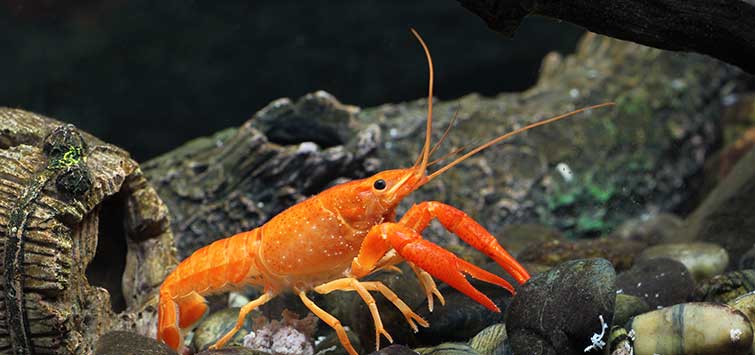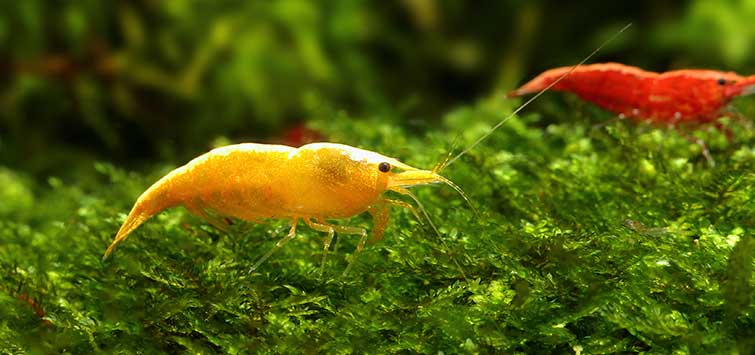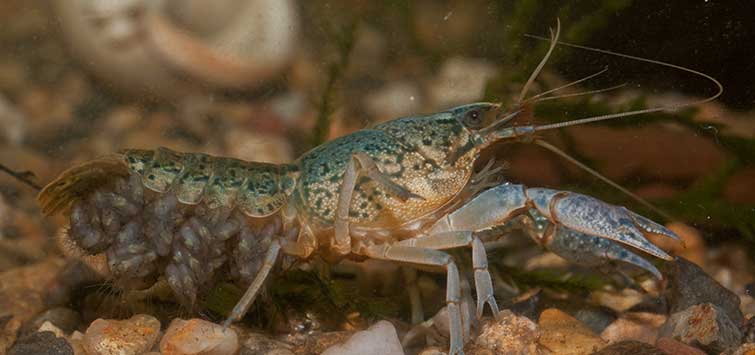The Orange Dwarf Crayfish
Author: Uwe Dost
The orange dwarf crayfish is an uncommon and colorful cray that makes for an ideal breeding project in the home aquarium. One international traveler ventured to Mexico to collect these gorgeous crustaceans and bring them home to breed.
Collecting Invertebrates
Freshwater invertebrates have really captured the attention of the hobby, with crustaceans (especially shrimps) generating a lot of hype. Another popular type of crustacean is the dwarf crayfish (Cambarellus patzcuarensis or C. shufeldtii). In particular, the orange color morph of the striped dwarf crayfish (C. patzcuarensis) has a wide distribution and is offered in pet shops all over the world. Additionally, there is a chocolate-brown color morph of the striped dwarf crayfish, and of course, there is also the wild type.
As someone who is interested in all things aquatic, over the years, I have kept a lot of different species of fish and bred many of them, with livebearers being one of my favorite groups from the beginning. But I also have affection for shrimp and crayfish.
In the 1970s and 1980s, only a few species of crustaceans were brought home from collecting trips by enthusiastic aquarists. Sometimes pet shops would have some shrimp and crayfish that accidentally came in with a shipment of fish. All in all, the supply of invertebrates was very, very low compared to what we have today.
Years later, I brought back invertebrates that I caught on collecting trips. However, before they became popular, I found it difficult to sell the offspring of crayfish to pet shops or fellow hobbyists. That meant that most of the species disappeared from the hobby anyway.
History of the Orange Striped Dwarf Crayfish
According to some information I found online, the orange color morph of the striped dwarf crayfish originated in the Netherlands. Sometime around the late 1990s, it is likely that two hobbyists from the Netherlands, Simone and Brian Kabbes, brought some C. patzcuarensis home from a collecting trip in Mexico. Some of the crays were distributed to Juan Carlos Merino, who also was living in the Netherlands at the time.
He apparently bred the first orange-colored offspring of the striped dwarf crayfish. Young dwarf crayfish breed very easily, so at the beginning, only males of the orange color morphs were sold. This led to high prices for the in-demand color morph. Later on, some females were offered, but they were much more expensive than the males. Now, they are not expensive and most people can afford these nice little crays.
On the Quest for the Patzcuaro Dwarf Crayfish
I had a desire to travel to Mexico to collect aquatic animals, especially livebearers, and in the 1990s, I was able to do so. While there, we also looked for snails, shrimp, and crayfish. In 2000, during a trip through the central plateau of Mexico on a quest for goodeids, we visited Lake Patzcuaro, the home of the striped dwarf crayfish.
In fact, C. patzcuarensis is endemic to the lake, which is located in Michoacan at around 2,000 meters (6,500 feet) above sea level and nearly 60 kilometers (38 miles) southwest of the major city of Morelia. The lake has an expanse of nearly 90 square kilometers (55 square miles). The shoreline can move forward or backward a bit depending on the annual rainfall—because of drought and the recent human activities over the past few years, the lake lost 40 square kilometers (25 square miles) of surface area and 2.6 meters (8½ feet) of depth. Despite the large size of the lake, the average depth is only 5 meters (16 feet) and the deepest point is only 11 meters (36 feet).
We didn’t take any measurements of the water parameters in the lake, but my research showed that the temperature of the water ranges between 15° and 25°C (60° and 77°F) throughout the year. The pH is 6.5 to 8, the hardness changes from 12° to 18° German hardness, depending on rainfall, and the conductivity is at least 875 µs. The bottom of the lake is covered with mud. Years ago, the water must have been clear, but because of human activities—such as fertilizer and human and industrial waste getting into the lake, the water is milky grayish or green from algae blooms. During our visit, it was turbid with a milky white color.
Collecting Cambarellus patzcuarensis
We approached the west shore of Lake Patzcuaro, coming from Zacapu. The road mostly remains far away from the water, but at one place, we found a way to it. Behind a cattle meadow, a small footpath leads through the dense vegetation on the bank of the lake, but we couldn’t catch any aquatic animals because the water was too turbid.
After such a poor collecting stop, we looked for a night’s lodging near the harbor of Patzcuaro. The next morning, we first strolled through the market of Patzcuaro, where the locals offered their goods. We found the dried fishes to be the most interesting, especially the pez blanco. The white fish (Chirostoma estor) is endemic to the lake and is currently in danger of extinction. The pez blanco at the market was offered next to large crops, besides many other goods.
Rancho el Molino
After eating, we started looking for goodeids in this area. We especially wanted to find the location of Rancho el Molino, which is well known among livebearer enthusiasts as a good place to find a few species of goodeids. This time, we took the road along the eastern bank of the lake leading to Quiroga. A few kilometers away from Patzcuaro, the road crossed a small, water-filled ditch. It was the first water body we saw in the dry August landscape. Thanks to Google Earth, I now know it was the drainage of the El Molino spring.
At first, we were trapped in our car because we were scared of some snarling, barking dogs on one shore of the water body. Since they didn’t come toward us, we eventually left the car and started catching fish on the opposite bank using a telescoping net.
Our Findings
The first animal we saw was a small amphibian, followed by a snake that preys on fish—it was a garter snake of the genus Thamnophis. We pulled the net through the aquatic plants in the middle of the water and caught some water bugs, tadpoles, crayfish, and goodeids. One crayfish in particular attracted our attention—it was dark, nearly black colored, and completely covered with algae. This furred specimen was a real daredevil; he immediately took the opportunity to mate with a female crayfish in our photo tank. He was a very special fellow in every sense. Nevertheless, we returned the animals to the ditch after taking some photographs.
After some hours of searching, we finally found the Rancho El Molino spring. There we caught goodeids, aquatic insects, a Gammarus species, and Cambarellus patzcuarensis. The water parameters were a pH of 7 to 7.5, dKH (German carbonate hardness) of 5°, total hardness of 5°, and a water temperature of 18°C (64°F).
Keeping C. patzcuarensis
We took some of the crayfish from Rancho El Molino home to Germany, where I bred them for many years. Unfortunately, not one of the offspring produced was a spectacularly colored specimen. Looking back, I have to say that we found many small, similar-looking crays in those Mexican waters, but we didn’t find any extraordinarily colored specimens. That came as no surprise because in natural habitats, predators will easily pick out the brightly colored specimens. Now I regret that I didn’t take home the black male from the ditch on the road to Quiroga. Who knows, if I had, I might now have a black color morph of this crayfish.
Compared to many other crayfish, C. patzcuarensis is quite a peaceful species. They do threaten each other if they come too close together, but they don’t seriously harm one another. If the tank has a lot of structure forming plenty of hiding places, even in crowded tanks, it will be rare for any specimens to lose a pincer.
Tank Recommendations
In a 60-liter (16-gallon) tank equipped with plants (such as Java moss), leaves, roots, clay tubes, and other hiding places like stones and bricks, a large cray population could develop. Actually, even small fish, snails, and other water plants could be housed with the crayfish. In my tank, the striped dwarf crayfish are living together with guppies, dwarf swordtails, and snails, and even the offspring of these species survive. Only ill specimens are removed by the crays, helping to preserve the health of the entire community.
Water Requirements
Since they come from the central plateau of Mexico, they do not normally need a heater in their tank; as long as the room temperature is 20° to 22°C (68° to 72°F), the tank light will help warm the system to around 25°C (77°F), which will suit the crays. While the bottom of Lake Patzcuaro is covered with mud, sand or pebbles will make a fine substrate.
The water doesn’t need to be turbid like it is in the lake; normal, medium-hard tap water will suit them. The offspring of the crayfish are very tiny, so the filter intake should be covered with a sponge or net. Ideally, a tank with small shrimp or crayfish should be filtered by a Hamburg-style mattenfilter. The large amount of surface area in those types of filters allows plenty of room for microorganisms to colonize. They will help keep the water clean, and the currents produced by the filter won’t endanger the small fry.
Naturally, regular partial water changes must be conducted on a consistent basis. In terms of diet, they should be fed dried leaves, herbs, vegetables, fish flakes and pellets, live or frozen bloodworms, insect larvae, other worms, and pieces of mussel. A varied diet is the key to success when it comes to keeping and breeding these animals.
Breeding the Orange Striped Dwarf Crayfish
According to various sources, the crayfish will live for about two years. The temperature of the water will affect their growth rate, with warmer water causing them to grow faster. Young crays molt every three to four weeks, and older specimens molt up to two times per year. After three or four months, they normally reach about 1½ to 2 centimeters (0.6 to 0.8 inches) and are sexually mature.
The male will pin the female onto her back and deposit sperm packets near her stoma. This bag-like sex organ, sometimes called the annulus ventralis, is a typical structure seen in American crayfish.
Eggs
Depending on the water temperature, after 4 to 30 days, the female will usually extrude between 20 and 40 eggs, with a maximum of 60 eggs. This happens mostly in the shelter of the darkness of night. The females lie on their backsand bring their tails forward over their bodies, ending up in a sideways U-shaped position. The space in the center forms a protected nursery for the eggs. The unfertilized eggs and protein mucus are released into the nursery. The mucus acts as a protective cover and dissolves the male’s sperm packet so the eggs can get fertilized.
Using her pleopods (swimmerets), the female builds a cover of mucus around every single egg and uses a fiber to attach each egg separately to her pleopod. After that, the female gets back on her feet.
For the next three to five weeks, she moves her pleopods constantly to supply the eggs with fresh, oxygen-rich water and to prevent dirt from accumulating on the eggs. With her walking legs, the female cleans the eggs and removes spoiled ones.
While females of other crayfish species hide during this period and often stop eating, the orange striped dwarf crayfish females are not shy and walk around the tank even during the daytime. If there are no big fish in the tank and lots of shelter is available, they don’t show any fear. An easy way to check on the progress of the developing eggs is to attract females using food placed at the front of the tank. Amazingly, the color of the eggs can vary from green, yellow, whitish, or gray to dark, nearly black.
After hatching, young crays remain under the pleon (abdomen) of their mother until they are ready to take their first steps into the outside world without mom’s protection.
A Nice Addition
The orange striped dwarf crayfish makes a nice companion for small fish, plants, and snails in small tanks. If you keep them in a species setup with a lot of hiding places, you can keep quite a few adults and a lot of offspring will grow up together.
See the full article on TFH Digital http://www.tfhdigital.com/tfh/201304#pg67

.png?h=595&iar=0&w=2781&hash=5FD5E69473BCC22199FBFA2FB71B6033)



